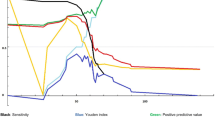Abstract
Introduction and hypothesis
While primary bladder outlet obstruction (BOO) in women has become an increasingly recognized entity over the past few years, the optimal management for such condition is yet to be defined. We assessed the effect of urethral calibration in the treatment of female BOO.
Methods
A retrospective review of female patients undergoing urethral calibration with urethral dilator for BOO from 2000 to 2009 was performed. BOO was defined as a maximum flow rate (Qmax) of less than 15 ml/s together with a detrusor pressure at maximum flow rate (PdetQmax) of more than 20 cmH2O in urodynamic studies in the absence of neurological disorders or mechanical causes. Pre-calibration and post-calibration urodynamic studies were compared.
Results
Twenty women were diagnosed of BOO on urodynamic criteria (mean age 56 ± 14 years). Sixty percent of the patients had obstructive symptoms, while 50% of them had irritative symptoms. Reassessment urodynamic studies were performed 6 months after urethral calibration. Although there was no significant change in Qmax and post-void residual urine after urethral calibration (9.6 ± 2.8 vs 9.7 ± 4.0 ml/s, p = 0.869 and 246 ± 196 vs 263 ± 198 ml, p = 0.753, respectively), PdetQmax significantly improved (72.2 ± 39 vs 50.2 ± 30.5 cmH2O, p = 0.013). Only one patient developed urinary tract infection after the procedure. No complication of incontinence had been observed. Among the 20 patients, 13 patients (65%) had a second urethral calibration after the reassessment urodynamic study for persistent symptoms.
Conclusions
Female patients with bladder outlet obstruction showed improvement in the urodynamic parameters after urethral calibration. However, its durability is not certain yet. Future studies concerning clinical symptoms correlation with urodynamic parameters would help further delineate the role of urethral calibration in the management of bladder outlet obstruction in women.
Similar content being viewed by others
References
Lemack GE, Zimmern PE (2000) Pressure flow analysis may aid in identifying women with outflow obstruction. J Urol 163(6):1823–1828
Chassagne S, Bernier PA, Haab F, Roehrborn CG, Reisch JS, Zimmern PE (1998) Proposed cutoff values to define bladder outlet obstruction in women. Urology 51(3):408–411
Athanasopoulos A, Gyftopoulos K, Giannitsas K, Perimenis P (2009) Effect of alfuzosin on female primary bladder neck obstruction. Int Urogynecol J Pelvic Floor Dysfunct 20(2):217–222
Haylen BT, Krishnan S, Schulz S, Verity L, Law M, Zhou J, Sutherst J (2007) Has the true prevalence of voiding difficulty in urogynecology patients been underestimated? Int Urogynecol J Pelvic Floor Dysfunct 18(1):53–56
Blaivas JG, Flisser AJ, Tash JA (2004) Treatment of primary bladder neck obstruction in women with transurethral resection of the bladder neck. J Urol 171(3):1172–1175
Nitti VW, Tu LM, Gitlin J (1999) Diagnosing bladder outlet obstruction in women. J Urol 161(5):1535–1540
Kuo HC (2005) Videourodynamic characteristics and lower urinary tract symptoms of female bladder outlet obstruction. Urology 66(5):1005–1009
Costantini E, Lazzeri M, Bini V, Zucchi A, Fioretti F, Frumenzio E, Porena M (2009) Open-label, longitudinal study of tamsulosin for functional bladder outlet obstruction in women. Urol Int 83(3):311–315
Massey JA, Abrams PH (1988) Obstructed voiding in the female. Br J Urol 61(1):36–39
Kumar A, Banerjee GK, Goel MC, Mishra VK, Kapoor R, Bhandari M (1995) Functional bladder neck obstruction: a rare cause of renal failure. J Urol 154(1):186–189
Patel R, Nitti V (2001) Bladder outlet obstruction in women: prevalence, recognition, and management. Curr Urol Rep 2(5):379–387
Axelrod SL, Blaivas JG (1987) Bladder neck obstruction in women. J Urol 137(3):497–499
Defreitas GA, Zimmern PE, Lemack GE, Shariat SF (2004) Refining diagnosis of anatomic female bladder outlet obstruction: comparison of pressure-flow study parameters in clinically obstructed women with those of normal controls. Urology 64(4):675–679
Blaivas JG, Groutz A (2000) Bladder outlet obstruction nomogram for women with lower urinary tract symptomatology. Neurourol Urodyn 19(5):553–564
Akikwala TV, Fleischman N, Nitti VW (2006) Comparison of diagnostic criteria for female bladder outlet obstruction. J Urol 176(5):2093–2097
Pischedda A, Pirozzi Farina F, Madonia M, Cimino S, Morgia G (2005) Use of alpha1-blockers in female functional bladder neck obstruction. Urol Int 74(3):256–261
Lemack GE, Foster B, Zimmern PE (1999) Urethral dilation in women: a questionnaire-based analysis of practice patterns. Urology 54(1):37–43
Kessler TM, Studer UE, Burkhard FC (2006) The effect of terazosin on functional bladder outlet obstruction in women: a pilot study. J Urol 176(4 Pt 1):1487–1492
Koh JS, Kim SJ, Kim HS, Kim JC (2011) Comparison of alpha-blocker, extracorporeal magnetic stimulation alone and in combination in the management of female bladder outlet obstruction. Int Urogynecol J Pelvic Floor Dysfunct 22:849–854
DasGupta R, Fowler CJ (2003) The management of female voiding dysfunction: Fowler's syndrome—a contemporary update. Curr Opin Urol 13(4):293–299
Giesy JD, Finn JC, Hermann GD, Kinney TB, Fogarty TJ (1984) Coaxial balloon dilation and calibration of urethral strictures. Am J Surg 147(5):611–614
Bashi SA (1988) The urethral syndrome. Int Urol Nephrol 20(4):367–374
Carson CC, Segura JW, Osborne DM (1980) Evaluation and treatment of the female urethral syndrome. J Urol 124(5):609–610
Rutherford AJ, Hinshaw K, Essenhigh DM, Neal DE (1988) Urethral dilatation compared with cystoscopy alone in the treatment of women with recurrent frequency and dysuria. Br J Urol 61(6):500–504
Sand PK, Bowen LW, Ostergard DR, Bent A, Panganiban R (1989) Cryosurgery versus dilation and massage for the treatment of recurrent urethral syndrome. J Reprod Med 34(8):499–504
Thompson IM, Baker JJ (1970) The histologic effects of dilation and internal urethrotomy on the canine urethra. J Urol 103(2):168–173
Tanagho EA, Lyon RP (1971) Urethral dilatation versus internal urethrotomy. J Urol 105(2):242–244
Conflicts of interest
None.
Author information
Authors and Affiliations
Corresponding author
Rights and permissions
About this article
Cite this article
Yee, C.H., Ho, L.Y., Hung, H.H. et al. The effect of urethral calibration on female primary bladder outlet obstruction. Int Urogynecol J 23, 217–221 (2012). https://doi.org/10.1007/s00192-011-1515-z
Received:
Accepted:
Published:
Issue Date:
DOI: https://doi.org/10.1007/s00192-011-1515-z




